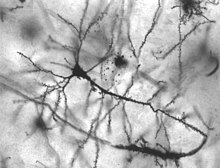Pyramidal cell
The pyramidal cells are a type of particularly large nerve cells . They get their name from the shape of their cell body , which appears to have three ends in the sectional view and thus resembles a pyramid or a cone. This type of cell occurs only in the cerebral cortex ( cortex cerebri ) and in the almond kernels of mammals , where it makes up about 85% of the nerve cells, the remaining 15% are called stellate cells .
morphology

Pyramidal cells are densely packed like columns throughout the cortex, mainly in the third and fifth layers of the cortex. Its fine dendrites are characterized by a roped ladder ( John Carew Eccles describes them as “an ammunition belt”) arranged, exciting contacts with stellate cells, while inhibitory synapses are predominantly located on the cell body . The axon branches root-like in different directions and forms tens of thousands of exciting synapses on a number of cells, some of which are very distant.
In both primates and rodents , the cell body of a pyramidal cell extends over about 20 μm. Individual dendrites are usually several hundred micrometers long. The basal neurite of a pyramidal cell is often significantly longer, usually several centimeters, and can project to distant nerve cells. In addition to the shape and the large cell body, a morphological peculiarity is the ability to form very long connecting lines. The largest pyramidal cells are the Meynert cells in the visual cortex and the Betz cells in the primary motor cortex . Axons can be over a meter long, especially in the pyramidal tract .
Incoming information (afferents)
Each pyramidal cell receives two different forms of afferent excitation, specific and non-specific. The specific afferents lead e.g. B. the information from the sensory organs from the thalamus to the cortex, they end at the cell body. The unspecific excitations and inhibitions of the pyramidal cells originate from the unspecific activation system ( ARAS ) of the reticular formation and reach the cerebral cortex from the thalamus via the basal ganglia . Here they are first switched to star cells, which in turn act on the dendrites of the pyramidal cells with a special, rope ladder-shaped synaptic connection. These unspecific excitations from the reticular part of the thalamus are rhythmic and act synchronously over the whole cortex, activating or inhibiting the level of alertness and attention , and if they are slower than 6 Hz, the cerebral cortex is put to sleep . During sleep, the pyramidal cells hardly react to stimuli, only very strong "wake-up stimuli" make them aroused.
The electrical voltage fluctuations that can be registered by the scalp with the EEG are the expression of these synchronous, unspecific excitations.
Networking
As in many parts of the nervous system, the convergence-divergence principle applies to the specific excitations of the pyramidal cells, which means that every cell is excited by many others and itself sends impulses to many other nerve cells. Each part of the cerebral cortex is connected to a mirror-image part of the other hemisphere via the bars , but the pyramidal cells also form widely diversified connections in the same side, connections to the cerebellum , brain stem , etc.
The growth of these innumerable, unmanageable connections and the formation of synaptic contacts among the pyramidal cells takes place particularly strongly in the first months and years; it is the growth of the neural networks that have been seen as carriers of the memory function since Donald O. Hebb described it .
